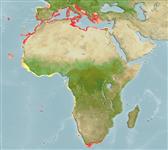Common names from other countries
Environment: milieu / climate zone / depth range / distribution range
Sinh thái học
; Mức độ sâu 1 - 110 m (Ref. 85345). Subtropical; 46°N - 37°S, 26°W - 32°E
Eastern Atlantic and the Mediterranean.
Length at first maturity / Bộ gần gũi / Khối lượng (Trọng lượng) / Age
Maturity: Lm ? range ? - ? cm Max length : 60.0 cm WD con đực/không giới tính; (Ref. 114251)
Maximum length is in body diameter (Ref. 114251). Infaunal; found on sandy substrates (Refs 106821, 106822). Common on bottoms covered with seagrasses and also occurs on detritic and muddy bottoms (Ref. 106822). Main diet include gastropods and bivalves (Ref. 106164).
Life cycle and mating behavior
Chín muồi sinh dục | Sự tái sinh sản | Đẻ trứng | Các trứng | Sự sinh sản | Ấu trùng
Members of the class Asteroidea exhibit both asexual (regeneration and clonal) and sexual (gonochoric) means of reproduction. Life cycle: Embryos hatch into planktonic larvae and later metamorphose into pentamorous juveniles which develop into young sea stars with stubby arms.
MarineSpecies.org. 2050. (Ref. 3477)
IUCN Red List Status (Ref. 130435)
CITES status (Ref. 108899)
Not Evaluated
Not Evaluated
Threat to humans
Harmless
Human uses
| FishSource |
Các công cụ
Thêm thông tin
Age/Size
Sự sinh trưởng
Length-weight
Length-length
Hình thái học
Ấu trùng
Sự phong phú
Các nguồn internet
Estimates based on models
Preferred temperature
(Ref.
115969): 14.3 - 21, mean 18.2 (based on 276 cells).
